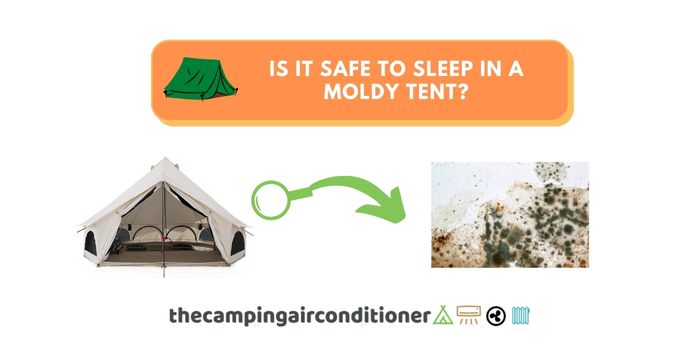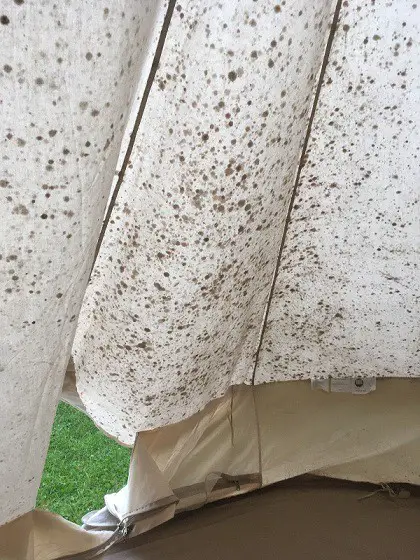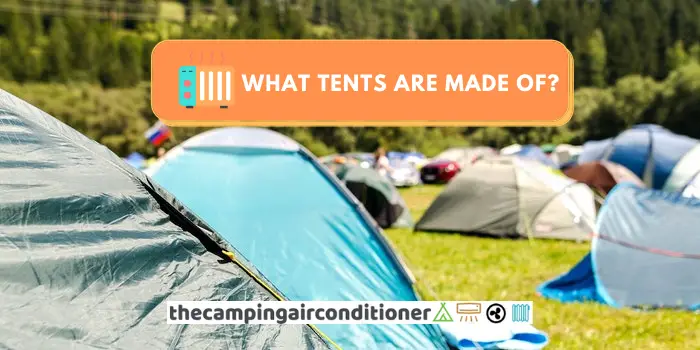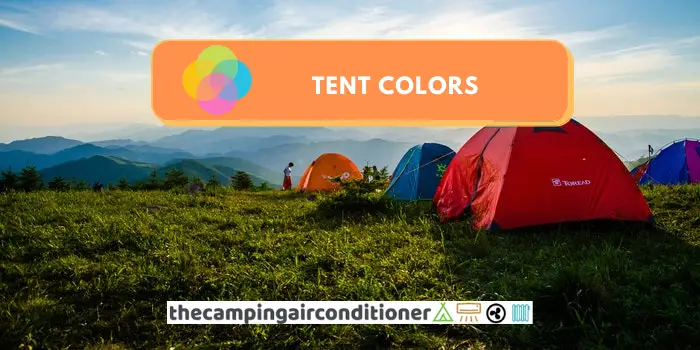Camping is the best way to enjoy nature in a carefree and close-to-nature setting. And that’s what makes it so great! The problem is that many other things can interfere with your camping experience. One of those things? Mold.
Mildew, mold, and other types of fungus grow easily in areas with high levels of humidity and temperature, especially when there’s dampness and water around.
Mold is dangerous and can cause several health problems, even in small amounts. It can be especially dangerous for children, pets, and the elderly, who can suffer from health problems like dry eyes or skin rashes due to allergies.
It is also well known to be harmful to people with respiratory diseases like asthma and tuberculosis as it can worsen the symptoms or trigger allergic reactions.
Overall, we do not recommend you sleep in a moldy tent. However, if you have found some traces of these organisms in your gear, don’t panic – in most cases, you can remove them with simple steps and measures, as detailed in this article.
Keep reading to learn more about what mold is, how to remove and prevent it, and whether you should sleep in a moldy tent.

By the way, The Camping Air Conditioner is sponsored by readers. When you buy through one of our links, we may earn an affiliate commission at no extra cost to you.
What is mold? (and why is bad to have in your tent?)
Mold is a type of fungus that can grow in many places, but it’s most common near or around water and in an environment with high humidity. Most mold variants tend to grow and spread very fast on damp surfaces such as toilets, showers, walls, basements and crawl spaces.
Mold can cause allergic reactions in people with sensitive immune systems and cause respiratory issues. Some variants produce toxins called mycotoxins, which may lead to severe illness, cancer induction, and immune deficiency in food-borne types, according to the World Health Organisation.
Mold may reside on any porous surface with enough moisture, like carpeting or wood. In your house, it is often found in damp environments such as closets or basements and warm and wet areas such as bathrooms or kitchens.
How do they occur in tents? We explain below.
What causes mold in a camping tent?
If you suspect that you have mold in your tent, you haven’t been doing a great job of keeping it dry. Or, in some cases, the tent was made with mold-friendly material (read below to check which fabrics can develop mold).
As previously discussed, this fungus is the best friend of a damp environment, so if you store your gear in a hot environment with high humidity, mold will likely grow and spread around.
Also, you might be exposed to mold growth during camping trips if you are staying close to areas with sources of moisture, like lakes or rivers or if there is extra humidity caused by a nearby jungle or forest.
(By the way, read this article to check some times on how to camp in high humidity).
What tent fabrics develop mold?
Different tent fabrics will have different tolerance levels to mold growth, as detailed below:
- Polyester – Polyester is a common synthetic tent fabric that is easy to clean and often quite strong. However, it can also be prone to mold and mildew if you don’t treat it properly after camping, especially if there is any soil or organic traces from which these organisms can feed., according to this note from the Canadian Government.
- Nylon/PVC – Similar to polyester, Nylon is a synthetic fabric that can be susceptible to mold with the presence of organic material.
- Canvas – It is probably the most susceptible to this fungus growth, given its organic composition (cotton and linen) that is “mold-friendly”
Bear in my that whatever tent fabric you are using or planning to buy, always keep your gear clean and dry.
| Tent Fabric | Prone to Mold? | Note |
| Polyester | Lower probability | Synthetic fabric – avoid storing it wet and with organic remainings, if you want to prevent mold growth |
| Nylon | Lower probability | Synthetic fabric – avoid storing it wet and with organic remainings, if you want to prevent mold growth |
| Canvas | Higher Probability | Organic Fabric – Susceptible to mold growth just with water, given organic nature |

Can I sleep in a moldy tent?
We do not recommend it, given the implications for your health and respiratory system. However, a small group of people suffer no ill effects from sleeping in tents with these microorganisms (hopefully, you are one of them because we always suffer with it).
The majority of people experience a variety of symptoms ranging from allergic reactions to breathing problems, including runny rose, eye irritation, and constant sneezing.
This can be especially dangerous if you are asthmatic or have other conditions that make you more sensitive to the spread of mold and mildew.
While scientists haven’t proven exactly how harmful it is to live in or sleep in an environment with mildew, there are certainly many indications that suggest that exposure can do harm over time. This would also seem to hold true for camping tents as well.
Do I need to dispose of a tent that has been contaminated by mold?
Well, it depends.
If the mold is not too severe, you can clean your tent using some simple steps, as in the next section below. A mixture of water and bleach (always non-chlorine!) can sometimes be effective in completely removing any traces of mold from your tent – use it carefully, though, as it might stain your tent.
However, some mildew stains can be impossible to completely remove. One thing that you can do to get rid of the odour leftover from mildew is to use a commercial mildew stain remover spray, such as RMS-866 isntand mold and mildew remover (see below).
- Remove mold and odors
- No Scrubbing needed
- Very cheap!
How can I remove mold from my tent?
There are a number of different methods that have been used by campers to get rid of these harmful microorganisms. Here are some of the most effective in removing them from your tent and camping gear:
1. Washing with warm water and soap: If you can’t manage to get the mold out of your tent in a number of showers, you may consider washing it with warm water and soap. Use a gentle detergent, and be sure to rinse well.
2. Undiluted white vinegar: This is the simplest way to remove mould from fabrics, but it has a strong smell that is not for everyone! If you don’t mind the smell, then one or two applications will take care of the problem. Just pour some over the affected area, wait a few minutes, and then scrub out with a glass of warm water (be careful when scrubbing to avoid damage to your fabric). We advise letting it dry in an open and ventilated area so that odours are carried away.
3. Bleach: If you know that your tents have been exposed to mildew, you can also apply some bleach to get rid of it. Non-chlorine options work well without damaging fabrics, but you can use regular bleach for colour-safe fabrics.
4. Use an industrialised solution, such as RMS-866 isntand mold and mildew remover.
Editor’s Note: Bleach, vinegar and detergents may corrode your tent if they are used on sensitive material. Be sure to read the manufacturer’s instructions so you can determine the best way to remove these fungi from your tent.
How can I prevent mold from growing in my tent?
There are several ways to prevent mold from growing in camping tents:
- Tent moisture management: Whenever possible, avoid camping in humid areas, especially near lakes or rivers where the surrounding plants and ground tend to draw in moisture. If you can’t prevent these types of camping environments, make sure that your tent is completely dried out after each use.
- Wipe off moisture: Always wipe off excess moisture from your tent before you pack it away. This includes both rain and condensation from the warm air inside the tent (by the way, you might be interested in this article – Will a heater stop condensation in my tent?).
- Keep your tent clean: As discussed, organic material remainings might support the development of not only fungi but also bacteria.
- Air Circulation: Make sure you camp in a tent with good ventilation so that dampness is removed from your shelter. It might be good to consider a solar-powered camping fan, such as BusyPiggy solar fan with Led (a very cheap option – less than 30 bucks- see below!).
- USB / Solar Powered
- LED Light embedded
- Affordable!
- Don’t use moldy camping gear: Last but not least, if you ever notice that a piece of camping gear has become infected while in storage, it is best to separate it away and not bring it to your trip (you don’t want your other gear to get contaminated). Fungi can spread incredibly fast, especially in scorching and wet weather.
Final Thoughts
Ensuring that your tent and camping equipment stay dry, clean and get plenty of air circulation is essential in preventing the growth of unwanted microorganisms.
If you suspect mould is growing in your tent, clean it immediately and do not sleep on it. Remember that allergic reactions to mold can be serious and possibly life-threatening.
Breathing in mold spores can cause lung inflammation, leading to respiratory disorders.If you feel an immediate reaction such as a stuffy throat and difficulty breathing after camping in a damp tent, don’t hesitate to look for medical help immediately.
Make sure that your medical providers understand that you have been exposed to these fungi so they can administer the proper procedure for any reactions.







